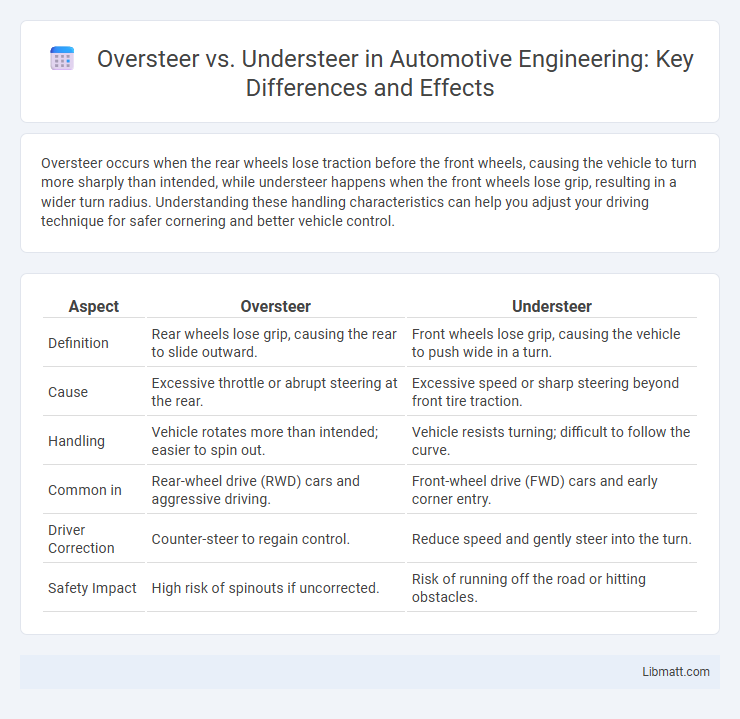Oversteer occurs when the rear wheels lose traction before the front wheels, causing the vehicle to turn more sharply than intended, while understeer happens when the front wheels lose grip, resulting in a wider turn radius. Understanding these handling characteristics can help you adjust your driving technique for safer cornering and better vehicle control.
Table of Comparison
| Aspect | Oversteer | Understeer |
|---|---|---|
| Definition | Rear wheels lose grip, causing the rear to slide outward. | Front wheels lose grip, causing the vehicle to push wide in a turn. |
| Cause | Excessive throttle or abrupt steering at the rear. | Excessive speed or sharp steering beyond front tire traction. |
| Handling | Vehicle rotates more than intended; easier to spin out. | Vehicle resists turning; difficult to follow the curve. |
| Common in | Rear-wheel drive (RWD) cars and aggressive driving. | Front-wheel drive (FWD) cars and early corner entry. |
| Driver Correction | Counter-steer to regain control. | Reduce speed and gently steer into the turn. |
| Safety Impact | High risk of spinouts if uncorrected. | Risk of running off the road or hitting obstacles. |
Introduction to Oversteer and Understeer
Oversteer occurs when the rear tires lose traction before the front tires, causing the vehicle's rear to slide outward during a turn, challenging driver control. Understeer happens when the front tires lose grip first, leading the vehicle to continue straight despite steering input, making it difficult to navigate corners. Understanding these dynamics is crucial for optimizing vehicle safety and handling performance on various road conditions.
Defining Oversteer: Causes and Characteristics
Oversteer occurs when the rear tires lose traction before the front tires, causing the vehicle's rear to slide outward during a turn. This phenomenon is often caused by excessive throttle input, sudden steering changes, or slippery road conditions. Key characteristics of oversteer include increased rear-end instability and the need for counter-steering to maintain control.
What is Understeer? Key Symptoms and Factors
Understeer occurs when your vehicle's front wheels lose traction during a turn, causing it to continue straight despite steering input. Key symptoms include a sluggish response to steering and the car feeling as if it's pushing wide in curves. Common factors contributing to understeer are excessive speed entering corners, front tire wear, and improper weight distribution.
Main Differences: Oversteer vs Understeer
Oversteer occurs when the rear tires lose grip before the front tires, causing the vehicle's rear end to slide outward during a turn, while understeer happens when the front tires lose traction first, leading the vehicle to continue straight instead of following the intended curve. Oversteer typically results in a tighter turning radius but requires corrective steering to prevent a spin, whereas understeer causes the vehicle to push wide in a turn, reducing cornering effectiveness and control. Understanding the balance between oversteer and understeer is crucial for optimizing vehicle handling and safety in various driving conditions.
Driving Dynamics: How Oversteer and Understeer Affect Handling
Oversteer occurs when the rear tires lose grip, causing the vehicle's rear to slide outward during cornering, which can lead to reduced steering control but increased maneuverability for skilled drivers. Understeer happens when the front tires lose grip, causing the vehicle to continue straight despite steering input, resulting in decreased turning ability and safer, more predictable handling for average drivers. Understanding the balance between oversteer and understeer is crucial for optimizing driving dynamics, as each affects traction, stability, and driver response in varying road and speed conditions.
Common Causes of Oversteer in Vehicles
Oversteer in vehicles commonly results from excessive throttle application during cornering, causing the rear tires to lose grip and slide outward. Another frequent cause is abrupt steering inputs or sudden weight transfer to the front wheels, reducing rear tire traction. Tire conditions, such as worn rear tires or incorrect pressure, also significantly contribute to oversteer by diminishing rear-end stability.
Typical Situations Leading to Understeer
Understeer typically occurs when your front tires lose grip during cornering, often caused by entering a turn too quickly or accelerating while steering. Common situations include driving on wet or slippery surfaces, sudden steering inputs, or having worn front tires, which reduce the front axle's ability to respond. Understanding these scenarios helps you anticipate and correct understeer for safer handling.
Correcting Oversteer: Control Techniques
Correcting oversteer involves counter-steering by gently turning the steering wheel in the opposite direction of the skid to regain vehicle control. You should smoothly modulate the throttle to avoid further loss of traction while maintaining a balanced grip on the road. Effective oversteer correction relies on timely reactions and precise inputs to prevent spins and maintain safe handling.
Managing Understeer: Safety Tips
Managing understeer requires gently easing off the accelerator and steering smoothly to regain traction without abrupt movements. Maintaining proper tire pressure and vehicle balance significantly reduces the risk of understeer during sharp turns or slippery conditions. You can enhance safety by practicing controlled steering techniques and ensuring your tires are in good condition for optimal grip.
Oversteer vs Understeer: Which is More Dangerous?
Oversteer occurs when the rear wheels lose traction, causing the car to turn more sharply than intended, while understeer happens when the front wheels lose grip, making the vehicle continue straight despite steering input. Oversteer is generally considered more dangerous because it can lead to spinouts that require quick driver correction, posing a higher risk of losing control, especially at high speeds. Your ability to manage understeer is typically easier, as it involves reducing speed and regaining traction, making it less critical in emergency situations.
oversteer vs understeer Infographic

 libmatt.com
libmatt.com